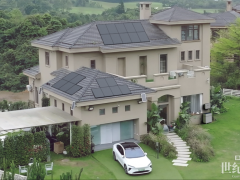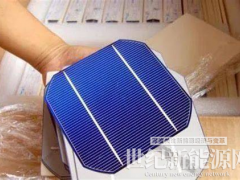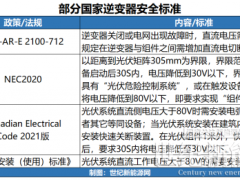本月初美國能源部部長朱棣文宣布了“屋頂光伏挑戰”(SunShot Rooftop Challenge)項目獲獎名單。普尼作為本次22個獲獎單位中為數不多的企業代表獲此殊榮,并得到美國能源部約86萬美元的資金資助。在這個項目里,普尼及其伙伴將致力于建立集中性的網絡資源中心與太陽能熱線,通過優化區域新能源推廣模式大大推動包括加州、猶他州、科羅拉多州和內華達州在內的西南部光照資源豐富地區的光伏市場發展速度。
這是普尼第二次榮獲美國能源部的獎勵,是對普尼商業模式和技術水平的又一次認可。普尼將繼續加強在新能源領域的技術、經驗和資源的全球積累,更好的為中外客戶服務。
關于普尼:普尼是一家世界領先的提供太陽能解決方案的跨國公司。普尼的客戶包括像華盛頓、舊金山那樣的低碳城市,希望通過新能源實現節能減排的政府及企業,大型太陽能電 站開發商,和像軍方那樣對太陽能有特殊需求的群體。普尼的優勢在于能夠整合、調動整個產業鏈的資源,把世界上最先進的經驗和技術用來滿足客戶的需求。普尼掌握多種最前沿的太陽能核心技術,并把基于這些技術的產品和服務作為客戶解決方案的組成部分。公司擁有在不同國家的多樣化系統集成經驗,累計達上百兆瓦。 普尼在美國和中國運營,并與美國國家可再生能源實驗室(NREL)、世界資源研究所(WRI)、北京大學等著名機構合作,攜手開發清潔能源,建設清潔世界。普尼的網站是www.optony.com。
美國能源部網站上列出了普尼和其他獲獎者的名單:http://energy.gov/articles/sunshot-rooftop-challenge-awardees。
(下文是美國能源部的新聞稿中文翻譯,英文原文附后。)
2011年12月1日,作者:金尼.西蒙,美國能源部
民用或商用太陽能發電站的成本多達40%都不是“硬性成本”,而是來自復雜的“軟性成本”,例如審批、區域規劃和光伏系統并網。事實上,今年年初SunRun發布的一份報告顯示,僅僅地方審批流程這一項就給美國每戶住宅的光伏安裝增加了2500多美元的成本。使事情更復雜的是,這些審批流程不僅繁瑣,而且每個地區都不一樣。
降低這些政策性壁壘是太陽能能夠與其他能源去競爭的關鍵。為了促進改變,美國能源部部長朱棣文今天宣布要獎勵1200萬美元給獲勝美國能源部舉辦的“屋頂光伏挑戰”的22個團隊。
遵循奧巴馬總統提出的“跑到最前面”的模式,每一個團隊要努力減少政策性成本,以促使美國使用太陽能變得更加容易。團隊們從明年開始有步驟地開展行動,包括規范光伏項目審批流程,更新區域規劃與規范,改良從太陽能發電到上網的標準,以及增加融資渠道。

上面地圖(摘自能源部網站,部分顯示,中間大圓是普尼,Optony Inc.)詳細標注了這22個團隊的所在區域位置,每個團隊正在做的項目和已經獲得的獎金數額。所有項目總計將惠及5100萬美國人。
舉幾個例子:紐約城市大學團隊的目標是通過建立多機構的網絡門戶把市級審批流程的時間從一年降至100天;佛羅里達州布勞沃德郡團隊計劃廢除當地限制太陽能安裝的一些條例,并且建立統一的網上審批與內部聯絡系統來減少成本和等待時間;此外,馬薩諸塞州團隊計劃在5個社區開展試點,從而制定能被應用推廣的最佳方案,也能夠解決民用安裝光伏系統的財務困難。
屋頂光伏挑戰項目是能源部“太陽計劃”(SunShot Initiative)的一部分。“太陽計劃”的目的是在10年內讓太陽能與其它任何一種能源相比具有成本競爭優勢,這也是美國能源部為了增加本國太陽能的有效利用和讓美國成為全球快速增長的光伏市場領導者的大布局的一部分。
能源部部長朱棣文說:“通過這個項目,能源部靠資助這些團隊挖掘了美國太陽能市場的潛力,使全美投資和應用太陽能變得更加迅速、便捷和低成本。這些團隊能夠降低民用和商用光伏系統的成本,同時為面臨預算緊張的地方政府節約了資金和時間。”
(下文是美國能源部的新聞稿英文原文。)
Rooftop Solar Challenge to Cut Solar's Red Tape
December 1, 2011
Ginny Simmons Managing Editor for Energy.gov, Office of Public Affairs
Up to 40 percent of the cost of installing solar panels onto your home or business isn't related to hardware at all, but rather due to complications from "soft costs," like permitting, zoning, and hooking your system up to the power grid. In fact, according to a report released earlier this year by SunRun, local permitting and inspection processes alone add more than $2,500 per residential installation nationwide. To add to the problem, permitting and other processes are often complicated and vary from jurisdiction to jurisdiction.
In order to make solar energy competitive with other types of energy, it will be critical to reduce these barriers. To spur change, Secretary Chu announced today $12 million in funding for 22 regional teams competing in the Energy Department’s "Rooftop Solar Challenge.”
Using President Obama's "Race to the Top" model, each of the teams will cut red tape to make it easier for Americans to go solar. Teams will implement step-by-step actions throughout the next year to standardize permit processes, update planning and zoning codes, improve standards for connecting solar power to the electric grid, and increase access to financing.
The map above details all 22 teams' locations, the projects each team will be undertaking, and the amount of funding they've been awarded. In total, their projects will cover a total population of more than 51 million Americans.
As examples, the team led by City University of New York aims to shorten the city’s approval process from one year to 100 days by creating an online multi-agency portal; the Broward County, Florida, team plans to remove local ordinances that create obstacles to solar installations and to create a unified online system for permitting and interconnection to reduce costs and wait time; and the Massachusetts team plans to use five pilot communities to determine best practices that can be replicated, as well as remove financing hurdles for homeowners.
The Rooftop Solar Challenge is part of the Energy Department’s SunShot Initiative, to make solar energy cost-competitive with any other form of energy by the end of the decade, and part of the Department’s larger effort to increase domestic solar deployment and position the U.S. as a leader in the rapidly-growing global solar market.
“Through this competition, the Energy Department is helping to unleash America’s solar potential by investing in projects that will make it faster, easier, and cheaper to finance and deploy solar power in communities across the country,” said Secretary Chu. “These awards will reduce the cost homeowners and businesses pay to install solar energy systems, while at the same time saving money and time for local governments faced with tight budgets.”
這是普尼第二次榮獲美國能源部的獎勵,是對普尼商業模式和技術水平的又一次認可。普尼將繼續加強在新能源領域的技術、經驗和資源的全球積累,更好的為中外客戶服務。
關于普尼:普尼是一家世界領先的提供太陽能解決方案的跨國公司。普尼的客戶包括像華盛頓、舊金山那樣的低碳城市,希望通過新能源實現節能減排的政府及企業,大型太陽能電 站開發商,和像軍方那樣對太陽能有特殊需求的群體。普尼的優勢在于能夠整合、調動整個產業鏈的資源,把世界上最先進的經驗和技術用來滿足客戶的需求。普尼掌握多種最前沿的太陽能核心技術,并把基于這些技術的產品和服務作為客戶解決方案的組成部分。公司擁有在不同國家的多樣化系統集成經驗,累計達上百兆瓦。 普尼在美國和中國運營,并與美國國家可再生能源實驗室(NREL)、世界資源研究所(WRI)、北京大學等著名機構合作,攜手開發清潔能源,建設清潔世界。普尼的網站是www.optony.com。
美國能源部網站上列出了普尼和其他獲獎者的名單:http://energy.gov/articles/sunshot-rooftop-challenge-awardees。
(下文是美國能源部的新聞稿中文翻譯,英文原文附后。)
2011年12月1日,作者:金尼.西蒙,美國能源部
民用或商用太陽能發電站的成本多達40%都不是“硬性成本”,而是來自復雜的“軟性成本”,例如審批、區域規劃和光伏系統并網。事實上,今年年初SunRun發布的一份報告顯示,僅僅地方審批流程這一項就給美國每戶住宅的光伏安裝增加了2500多美元的成本。使事情更復雜的是,這些審批流程不僅繁瑣,而且每個地區都不一樣。
降低這些政策性壁壘是太陽能能夠與其他能源去競爭的關鍵。為了促進改變,美國能源部部長朱棣文今天宣布要獎勵1200萬美元給獲勝美國能源部舉辦的“屋頂光伏挑戰”的22個團隊。
遵循奧巴馬總統提出的“跑到最前面”的模式,每一個團隊要努力減少政策性成本,以促使美國使用太陽能變得更加容易。團隊們從明年開始有步驟地開展行動,包括規范光伏項目審批流程,更新區域規劃與規范,改良從太陽能發電到上網的標準,以及增加融資渠道。

上面地圖(摘自能源部網站,部分顯示,中間大圓是普尼,Optony Inc.)詳細標注了這22個團隊的所在區域位置,每個團隊正在做的項目和已經獲得的獎金數額。所有項目總計將惠及5100萬美國人。
舉幾個例子:紐約城市大學團隊的目標是通過建立多機構的網絡門戶把市級審批流程的時間從一年降至100天;佛羅里達州布勞沃德郡團隊計劃廢除當地限制太陽能安裝的一些條例,并且建立統一的網上審批與內部聯絡系統來減少成本和等待時間;此外,馬薩諸塞州團隊計劃在5個社區開展試點,從而制定能被應用推廣的最佳方案,也能夠解決民用安裝光伏系統的財務困難。
屋頂光伏挑戰項目是能源部“太陽計劃”(SunShot Initiative)的一部分。“太陽計劃”的目的是在10年內讓太陽能與其它任何一種能源相比具有成本競爭優勢,這也是美國能源部為了增加本國太陽能的有效利用和讓美國成為全球快速增長的光伏市場領導者的大布局的一部分。
能源部部長朱棣文說:“通過這個項目,能源部靠資助這些團隊挖掘了美國太陽能市場的潛力,使全美投資和應用太陽能變得更加迅速、便捷和低成本。這些團隊能夠降低民用和商用光伏系統的成本,同時為面臨預算緊張的地方政府節約了資金和時間。”
(下文是美國能源部的新聞稿英文原文。)
Rooftop Solar Challenge to Cut Solar's Red Tape
December 1, 2011
Ginny Simmons Managing Editor for Energy.gov, Office of Public Affairs
Up to 40 percent of the cost of installing solar panels onto your home or business isn't related to hardware at all, but rather due to complications from "soft costs," like permitting, zoning, and hooking your system up to the power grid. In fact, according to a report released earlier this year by SunRun, local permitting and inspection processes alone add more than $2,500 per residential installation nationwide. To add to the problem, permitting and other processes are often complicated and vary from jurisdiction to jurisdiction.
In order to make solar energy competitive with other types of energy, it will be critical to reduce these barriers. To spur change, Secretary Chu announced today $12 million in funding for 22 regional teams competing in the Energy Department’s "Rooftop Solar Challenge.”
Using President Obama's "Race to the Top" model, each of the teams will cut red tape to make it easier for Americans to go solar. Teams will implement step-by-step actions throughout the next year to standardize permit processes, update planning and zoning codes, improve standards for connecting solar power to the electric grid, and increase access to financing.
The map above details all 22 teams' locations, the projects each team will be undertaking, and the amount of funding they've been awarded. In total, their projects will cover a total population of more than 51 million Americans.
As examples, the team led by City University of New York aims to shorten the city’s approval process from one year to 100 days by creating an online multi-agency portal; the Broward County, Florida, team plans to remove local ordinances that create obstacles to solar installations and to create a unified online system for permitting and interconnection to reduce costs and wait time; and the Massachusetts team plans to use five pilot communities to determine best practices that can be replicated, as well as remove financing hurdles for homeowners.
The Rooftop Solar Challenge is part of the Energy Department’s SunShot Initiative, to make solar energy cost-competitive with any other form of energy by the end of the decade, and part of the Department’s larger effort to increase domestic solar deployment and position the U.S. as a leader in the rapidly-growing global solar market.
“Through this competition, the Energy Department is helping to unleash America’s solar potential by investing in projects that will make it faster, easier, and cheaper to finance and deploy solar power in communities across the country,” said Secretary Chu. “These awards will reduce the cost homeowners and businesses pay to install solar energy systems, while at the same time saving money and time for local governments faced with tight budgets.”
 微信客服
微信客服 微信公眾號
微信公眾號









0 條